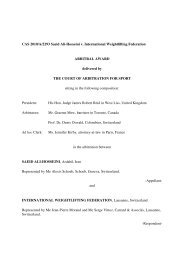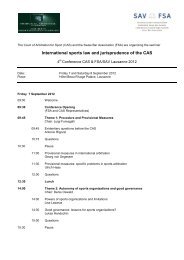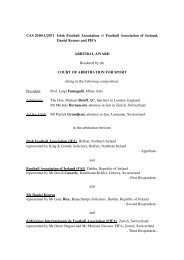(CAS) Bulletin - Tribunal Arbitral du Sport / TAS
(CAS) Bulletin - Tribunal Arbitral du Sport / TAS
(CAS) Bulletin - Tribunal Arbitral du Sport / TAS
Create successful ePaper yourself
Turn your PDF publications into a flip-book with our unique Google optimized e-Paper software.
Mr Scott notes that <strong>du</strong>ring the February 2006 tests<br />
run in the Lausanne WADA-accredited Laboratory,<br />
six collections were taken and not three as alleged<br />
by Dr Ashenden. Calculating Mr Contador’s natural<br />
value based on these six collections does not lead to a<br />
signifi cant difference compared to the data presented<br />
by Dr Ashenden based on three collections. However,<br />
without adequate explanation as to why some values<br />
were excluded and others were not, Mr Scott feels it<br />
is only appropriate to use the full set of data available.<br />
Another argument put forward by Mr Scott is that<br />
Dr Ashenden refers to two papers that indicate<br />
that the expected reticulocyte percentage values<br />
should be lower than those of an athlete’s out-ofcompetition<br />
values. None of the papers makes any<br />
attempt to evaluate a “natural ” value for an athlete’s<br />
reticulocytes nor makes any claims regarding such a<br />
“natural ” value. Furthermore, those papers are only<br />
studies and there is no controlled experiment to test<br />
a hypothesis.<br />
Based among others on this expert report of Mr.<br />
Scott, the Athlete concludes that, as acknowledged<br />
by the Appellants, his blood profi le does not evidence<br />
any transfusion or blood manipulation. The Athlete<br />
concludes that this point does not therefore merit any<br />
further examination.<br />
During the hearing, the discussion between Dr<br />
Ashenden and Mr Scott mainly focussed on how<br />
the Athlete’s “natural ” blood values are to be<br />
established. If the normal proce<strong>du</strong>re is followed and<br />
the comparison is made against the whole range of<br />
data in Mr Contador’s ABP, no abnormal results<br />
are found. However, if Mr Contador’s blood values<br />
<strong>du</strong>ring the Grand Tours between 2007 and 2010 are<br />
taken separately, then the values <strong>du</strong>ring the 2010<br />
Tour de France are “unusual ”.<br />
In his closing submissions, the UCI noted that the<br />
Athlete’s blood values may well be within the limits<br />
as argued by Mr Scott. However, the UCI added that<br />
this is not surprising because it is the purpose of<br />
manipulation.<br />
Findings of the Panel<br />
After considering the positions of all the parties and<br />
the expert reports of Dr Ashenden and Mr Scott, the<br />
Panel comes to the conclusion that the Athlete’s blood<br />
parameters cannot establish a blood transfusion. The<br />
Panel understands that the Appellants do not want<br />
to prove per se that the Athlete underwent a blood<br />
transfusion but only argue that a blood transfusion is<br />
more likely to have caused the presence of clenbuterol<br />
than the meat contamination scenario.<br />
It is noted that Dr Ashenden sliced the results of<br />
former blood values of Mr Contador, i.e. he used<br />
the samples taken <strong>du</strong>ring or shortly before or<br />
after the Grand Tours. The Panel is not convinced<br />
that the comparison con<strong>du</strong>cted by Dr Ashenden<br />
is a suffi ciently secure method of establishing<br />
inconsistencies in Mr Contador’s ABP.<br />
More specifi cally, after considering the positions of<br />
all the parties and the expert reports of Dr Ashenden<br />
and Mr Scott, the Panel fi nds that the inconsistencies<br />
that Dr Ashenden sees in Mr Contador’s ABP are not<br />
conclusive and are de<strong>du</strong>cted from too many uncertain<br />
blood parameters and comparisons, making them<br />
too speculative and insuffi ciently secure to rely on<br />
as convincing supporting evidence that an athlete<br />
underwent a blood transfusion.<br />
However, even if no inconsistencies in the Athlete’s<br />
ABP were established, in the opinion of the Panel,<br />
this does not make the blood transfusion scenario<br />
impossible, bearing in mind, among others, as the UCI<br />
rightly mentioned, that preventing inconsistencies in<br />
one’s ABP is precisely the purpose of transfusing<br />
plasma. This leads the Panel to the examination of<br />
the issue of the traces of phthalates.<br />
5.3 Traces of phthalates<br />
Phthalates are additives that are widely used in<br />
plastics and other materials, primarily to make them<br />
more fl exible. They are used in in<strong>du</strong>stry as well as in<br />
medical and consumer pro<strong>du</strong>cts.<br />
Different kinds of phthalates (also referred to as<br />
plasticisers or DEHP) are detected by laboratories<br />
in the anti-doping fi eld, including: Mono-(2ethyl-<br />
5-hydroxyhexyl) phthalates (5OH-MEHP), Mono-<br />
(2ethyl-5-oxohexyl) phthalates (5OXO-MEHP) and<br />
Mono-(2-ethylexyl) phthalates (MEHP). An elevated<br />
concentration of phthalates after blood transfusion<br />
has been shown in several recent studies. Some blood<br />
bags used for transfusion contain plasticizers, which<br />
can easily migrate into the blood.<br />
In relation to the samples collected from the Mr<br />
Contador the following fi ndings are undisputed:<br />
The day before Mr Contador tested positive to<br />
clenbuterol, i.e. on 20 July 2010, he provided another<br />
sample (n°2512049). This sample was tested by the<br />
Cologne Laboratory, which detected that it contained<br />
an extremely high concentration of phthalates. The<br />
concentration of 5OH-MEHP reported for the<br />
Athlete’s Sample was 478.5 ng/mL; for 5OXO-<br />
MEHP, the concentration was 208.6 ng/mL. These<br />
fi gures had been corrected and were based on a<br />
Jurisprudence majeure / Leading cases<br />
-<br />
129





